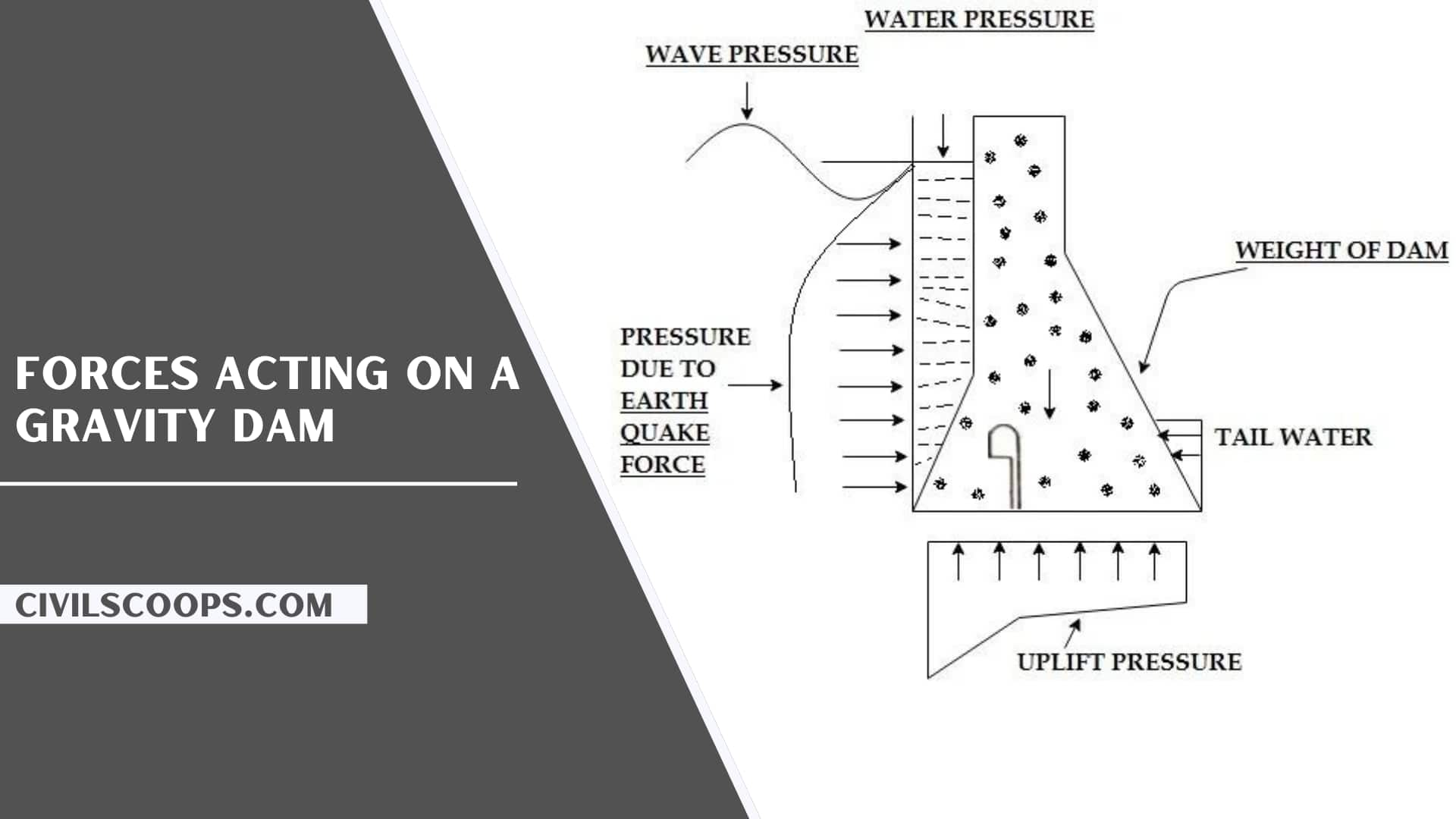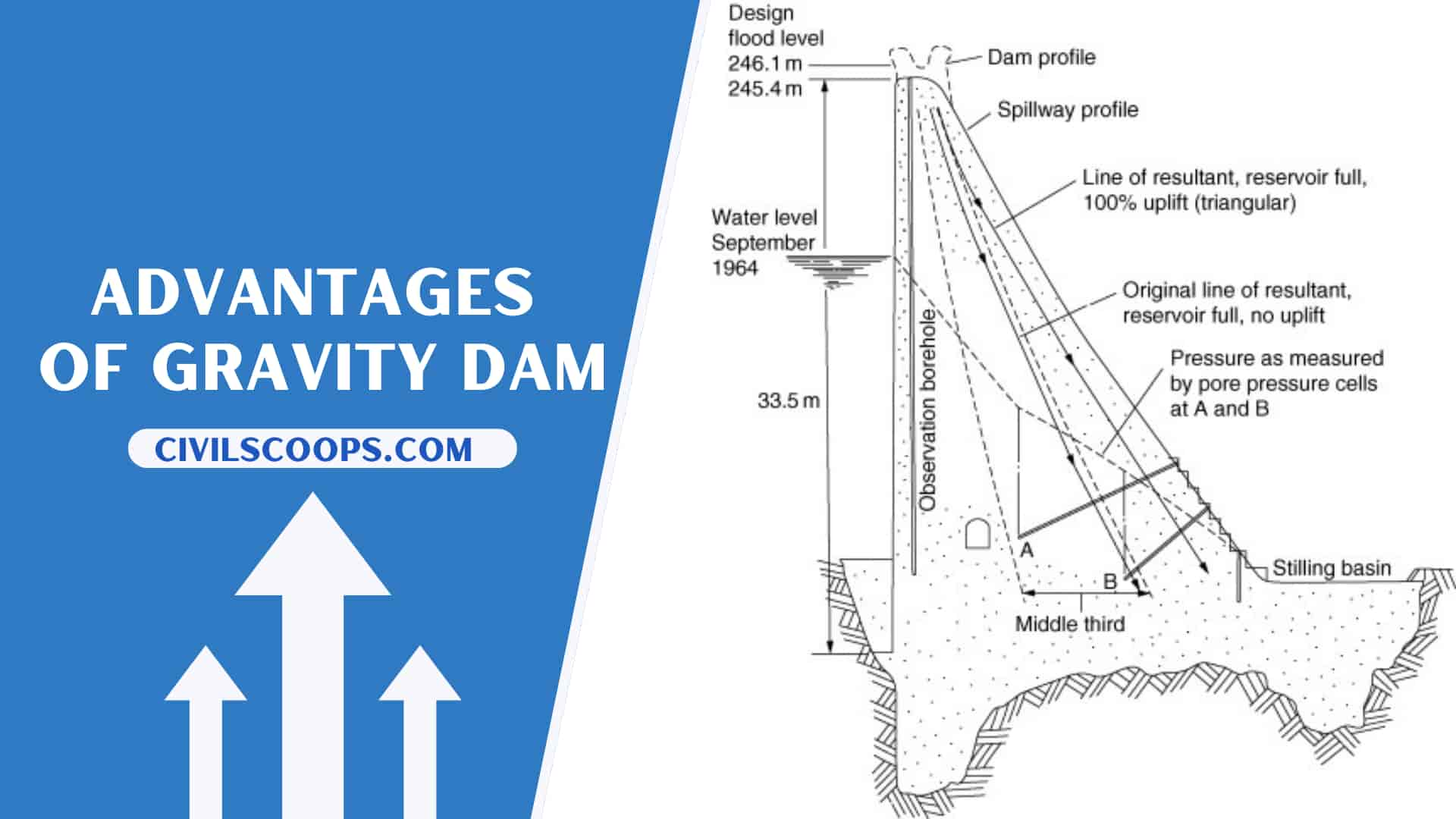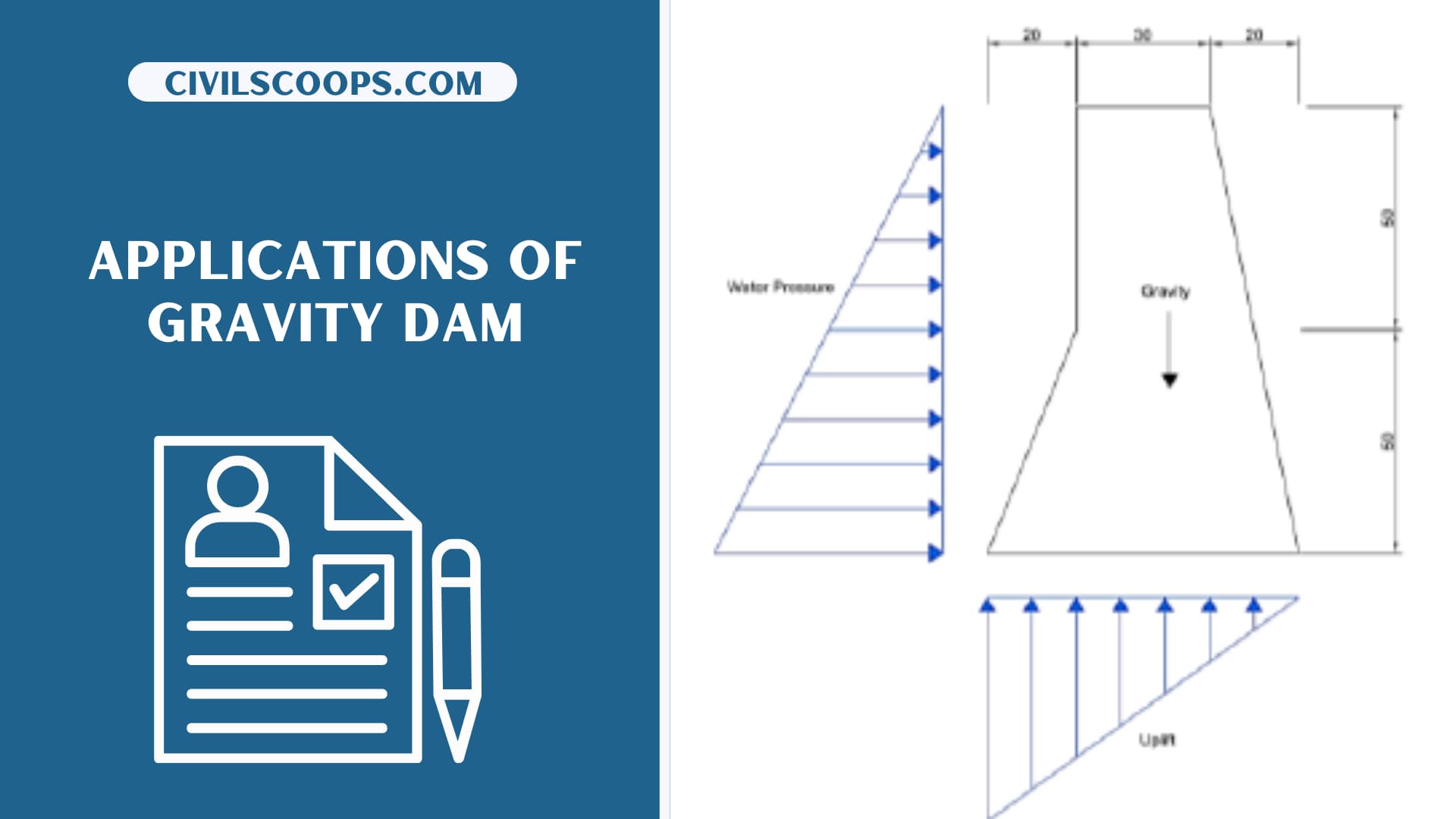Forces Acting on a Gravity Dam | Construction of Gravity Dam | Advantages & Disadvantages of Gravity Dam | Applications of Gravity Dam

Table of Contents
Introduction of Gravity of Dam
The Gravity dam is defined as a structure that is designed and constructed such that the own weight of the gravity dam resists the external forces.
The Gravity dam is most durable and solid which requires very less maintenance. The Gravity dam is constructed from masonry or concrete. Gravity dams are massive structures that are constructed with the help of stone or concrete.
The construction of concrete gravity dams is preferred as compared to the other types of dams. If suitable conditions and the site is available then the gravity dams can be constructed up to the greater heights. This types of dams are generally straight in the plan.
One of the highest and popular Gravity dams in the world is Grand Dixence Dam in Switzerland. The height of this dam is 284 m.
The highest and biggest gravity dam in India is the Bhakra Nangal Dam. The height of this dam is 226m. The gravity dams are more durable as compared to other types of dams.
Forces Acting on a Gravity Dam

There are various forces that are acting on the gravity dam. All these forces are explained with their magnitude direction and the point of action.
The forces of the gravity dam are expressed in the kilogram per meter run of the Dam.
1. Water Pressure on the Gravity Dam
The water pressure is the major external pressure that is acting on the Dam. This is the Overturning force acting on the gravity dam.
P1= (Wh2/2) which act from the base at h/3
Where,
w= Specific weight of the water
h= Height of water
2. Weight of the Wedge on the Downstream Slope
This is the force due to the weight of water on the downstream wedge acting at the centre of gravity in downwards.
P ( force) = (Whd2 /2)
Where,
hd = Depth of the water on the downstream side
3. Weight of Dam
Weight of the dam = Area of cross-section x unit weight of dam material acting at the centre of gravity of the dam section downwards.
The weight of the dam is an important and main stabilizing force in case of the gravity dam. For the analysis of the gravity dam, the unit width of the gravity dam is considered.
The total weight of the gravity dam acts at the centre of gravity of the cross-section.
4. Upstream Silt Pressure
The silt which is deposited on the upstream side of the dam exerts pressure on the dam. The silt which is deposited on the upstream side can be analyzed for any vertical forces in case the dam is sloped.
5. Seismic Forces or Earthquake Forces
It is very important that dam should be designed in all respects. If the dam is located in the earthquake zones, can you should be designed for the seismic forces.
The earthquake waves can cause damage to the foundation and the structure of the dam and there may be chances that the dam may be collapsed.
So it is necessary that the earthquake forces should be considered while designing and constructing the gravity dams.
P ( Earthquake force) = 500 h2
This force approximately acts at 0.42h from the base of the dam.
6. Uplift Force
This is the pressure due to the seepage of water through the foundation. It acts upwards on the foundation of the dam and reduces the effective weight.
7. Ice Pressure
In an extremely cold climate the top surface of the reservoir freezes into ice due to variations in temperature such as expand during the daytime and exert pressure on the dam.
This force acts along the length of the dam at the reservoir level. Magnitude of the Ice force ranges between 25 to 150 t/m2.
8. Wind Pressure
The wind force acting on all the export faces of the dam exerts pressure in the direction of the wind. The wind pressure depends on the speed of the wind.
The wind pressure acts on the export surface of the gravity dam. The section of the gravity dam is proportioned such that it will resist the external force acting on the gravity dam by its own weight.
Construction of Gravity Dam

The gravity dams are constructed on any site where the natural foundation is strong and rigid enough to bear the heavy load of the dam.
Gravity dams are constructed at the right angles to the flow of the water. During the construction of the gravity dam it is necessary to divert the flowing water of river temporarily.
The lower portion of the gravity dam should be constructed in dry weather because it will help to minimize the cost required for the diversion of the water.
The materials which are required for the construction of the gravity dams are sand, aggregate, cement, and reinforcement, etc. In the Gravity dam, the apex is at the top side and the maximum width is at the bottom side of the gravity dam.
The most suitable and preferred foundation for the construction of the gravity dam is a rock foundation. The rock foundation is the strongest foundation that will transmit the heavy weight of the gravity dam into the underneath strata of the soil.
The cross-section of the gravity dam is basically triangular in shape. In the construction of the gravity dam, low heat cement is used.
The materials which will be used in the construction of the gravity dam should be accessible nearby areas so that to reduce the transportation cost and the total cost of construction of the project.
Also Read: What Is Sealing Brick Work| Advantages of Brick Sealer | Types of Brick Sealer
Advantages of Gravity Dam

The various advantages of the gravity dam are as follows.
- The gravity dams are more stronger and rigid.
- the gravity dams are more stable and durable as compared to other types of dams.
- The gravity dam requires less maintenance.
- The construction of the gravity dam is suitable in the steep valleys because it is not possible to construct the earthen dams in
the steep valleys. - The Benefit-cost ratio of the Gravity dam is more.
- Gravity dams have the ability to hold a large amount of water.
- Gravity dams can be constructed upto any height but it is necessary that the foundation of the dam should be strong and rigid.
- There are less seepage problems in the case of gravity dams.
Also Read: 15 Different Types of Cement and Their Uses
Disadvantages of Gravity Dam

There are also some disadvantages of the gravity dam which are as follows.
- The initial cost required for the construction of the Gravity dams is high.
- The time required for the construction of the gravity dam is more.
- The construction of the Gravity dam required skilled labour.
- It is necessary that the construction of the gravity dams should have a strong and sound foundation.
- The design of the gravity dam is a little bit complex.
Applications of Gravity Dam

The applications of the gravity dam are as follows
- Gravity dam is used to store a large amount of water.
- Gravity dams are used for the supply of water for various purposes.
- It is also used for the purpose of Flood control.
- Gravity dams are also used for the generation of hydropower.
Measures Should Be Taken to Control Cracks in the Gravity Dams?
There are various measures to be taken to avoid cracking in gravity dam which are as follows.
- In the construction of the gravity dam special low heat, cement should be used.
- Proper suitable spaced contraction joints should be provided in addition to the normal construction joints.
- The material which will go into the concrete should be cooled before mixing the concrete.
- When the concrete is poured, it is poured to a certain height which is known as Lift. Generally, the lift which is used for the
gravity dam is 1.5 m.
[su_box title=”FAQ” style=”default” box_color=”#333333″ title_color=”#FFFFFF” radius=”3″ class=”” id=””]
Construction of Gravity Dam
A dam is constructed of concrete and/or masonry, which relies on its weight and internal strength for stability. A concrete gravity dam is constructed by the use of a dry mix of concrete transported by conventional construction equipment and compacted by rolling, usually with vibratory rollers.
Forces Acting on a Gravity Dam
Gravity dam case-i reservoir full case: When the reservoir is full, the major forces acting are the weight of the dam, external water pressure, uplift pressure, and earthquake forces in serious seismic zones. The minor forces are Silt Pressure, Ice Pressure, and wave Pressure.
Advantages of Gravity Dam
- It is highly suitable in narrow valleys.
- The maintenance cost is relatively lower.
- Such dams offer great flexibility in height.
- Sudden failure of the dam does not occur.
- The problem of seepage is lower.
Disadvantages of Gravity Dam
- Their initial cost of construction is high.
- Their construction period is comparatively more.
- These require a strong and sound foundation.
- Dams once constructed, cannot be raised further.
- For the supervision of concrete dams, skilled labor is required.
Application of Gravity Dam
Gravity dams are multifunctional and serve a variety of purposes. They help to control the flow of melting snow in a river during winter and spring and store water in the dry season. These dams can store a large amount of water which can be used for drinking water supply, electricity generation, irrigation, etc.
Gravity Dam Example
A typical example of a conventional concrete dam is the Hoover Dam. Changuinola Dam is an example of the RCC arch-gravity dam.
Gravity Dam Vs Arch Dam
Different thicknesses: A gravity dam is relatively thick while an arch dam is rather thin. The thickness of the upper arch dam body is always only 3–5 m so the temperature may drop from the maximum to a very low value in a very short time before the expansive deformation of MgO concrete could develop.
Forces Acting on Gravity Dam
External Forces Acting on Gravity Dam. Water Pressure. Uplift Pressure. Earthquake Forces.
Stability Analysis of Gravity Dam
Stability analysis for gravity dams often is simplified into a two-dimensional rigid body analysis of a cross-section of the structure (see Figure 1) and is focused on stability against sliding. In this analysis, the overturning of the dam is considered within the context of its potential influence on sliding.
Water Pressure on Dam
The deeper the water, the more horizontal pressure it exerts on the dam. So at the surface of the reservoir, the water is exerting no pressure and at the bottom of the reservoir, the water is exerting maximum pressure. The force acts at the center of gravity of the triangle — one-third of the way up from the bottom.
[/su_box]
[su_note note_color=”#F2F2F2 ” text_color=”#333333″ radius=”3″ class=”” id=””]
Like this post? Share it with your friends!
Suggested Read –
- What Are Weirs | Types of Weirs | Advantages & Disadvantages of Weirs | Operation & Limitations For Weir | Limitations of Weirs | Location of Weirs
- What Is Sealing Brick Work| Advantages of Brick Sealer | Types of Brick Sealer
- 15 Different Types of Cement and Their Uses
- 10 Different Between Mortar And Concrete | What Is Mortar & Concrete | Types of Mortar & Concrete
- What Are the Components of Stairs | 19 Different Types of Stairs Components
[/su_note]
Originally posted 2022-09-08 13:14:14.
